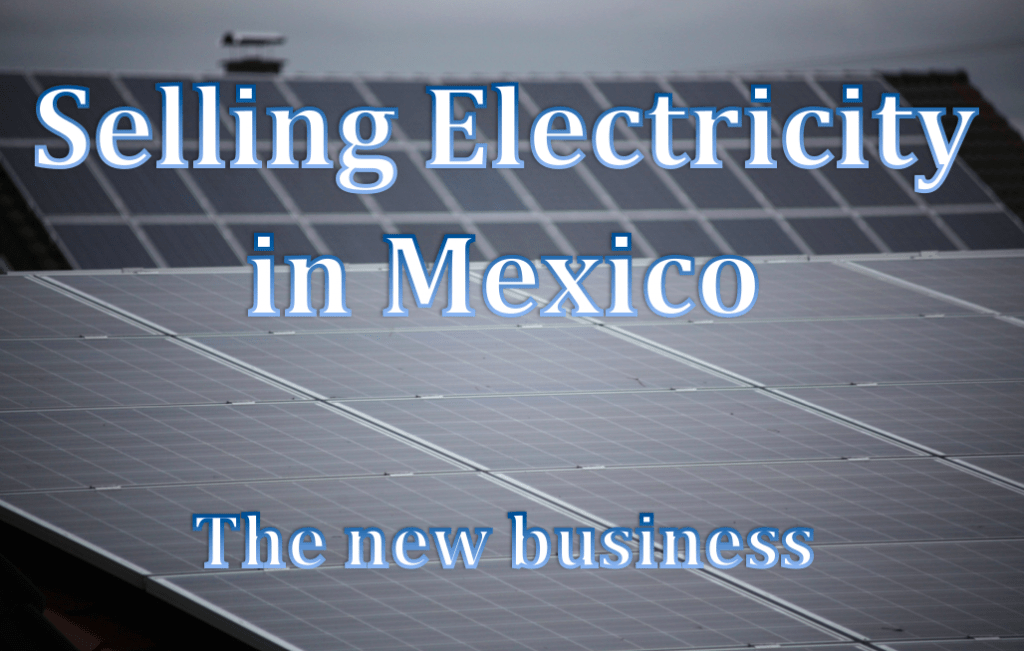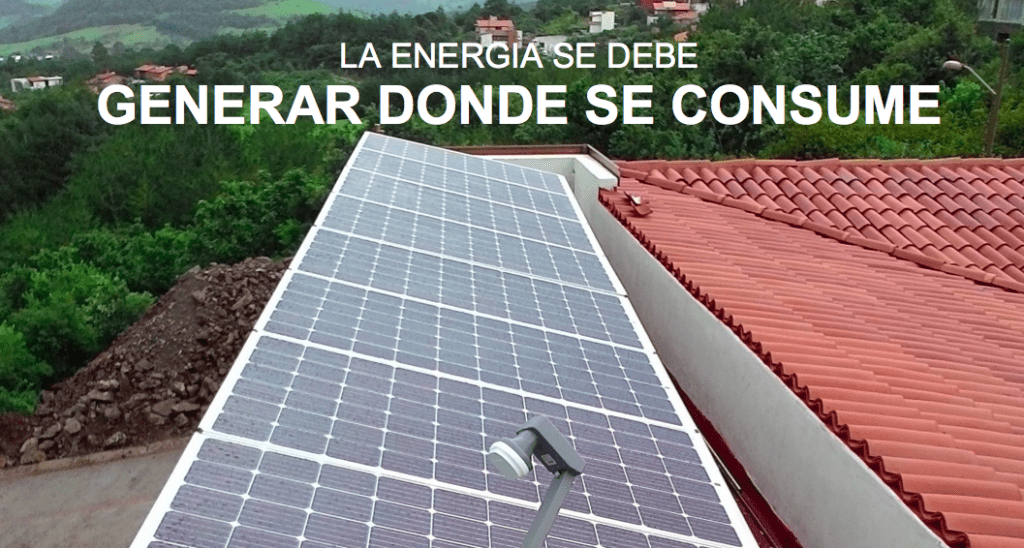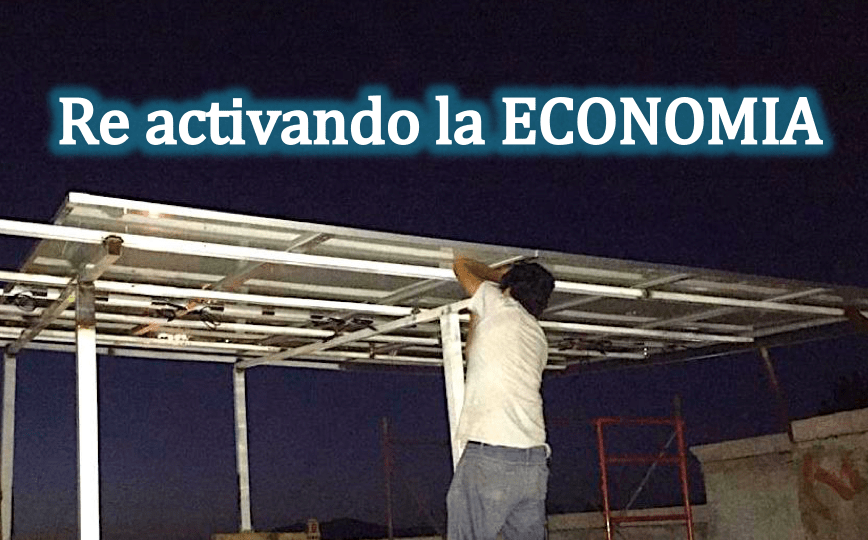Tecnoligente Energia Renvable SA DE CV, helps companies and private investors to enter the new opened energy market, Selling Energy in Mexico. If you are interested in a strong partner in Mexico, please contact us at contactanos@tecnoligente.com
Reform of the energy market: what’s new?
During December 2013, the ex-president Enrique Peña Nieto signed into law the constitutional reform of the Mexico’s energy market. So, the goal of the reform is to make the market more competitive. As a result, to reduce the energy bill of the Mexico’s citizens.
The new selling model gives the best opportunity to companies like Tecnoligente Energia Renovable SA DE CV helping householders and business to produce their own energy. Also they may be Selling Energy in Mexico to the CFE (Comisión Federal de Electricidad). This way, saving vast money on the electricity bill.
This reform also affects all the energy market (fuel, electricity, etc..). But in this article, we will only focus on the electrical reform.
Selling Energy in Mexico
The new model gives the opportunity to Private investors to Selling Energy in Mexico.
Before the constitutional reform, the electricity market of Mexico was a state monopoly operated by CFE. And this organism, was responsible for all the steps in the delivering process of electricity to consumers. This, from the generation, transmission, distribution and the supply of electricity. [1]
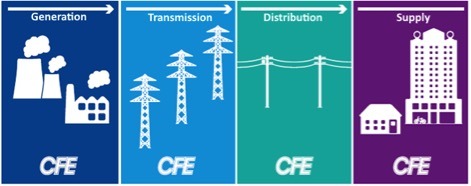
The constitutional reform aims to low the price of the electricity by opening its market to the competition. This reform follows the trend of the European’s energy market reform, implemented 17 years before. [3] In the new Selling Energy in Mexico, two of the four steps described before are now opened to the competition.
The first one is the generation. And the second one is the supply.
The transmission and the distribution, for their part, stay publics services managed by the state and operated by CFE. So even if the law include the possibility for CFE to conclude association with the private sector to operate the grid.
Private Companies
To produce electricity as a private company the rules were strict. Mainly all the producers were either directly consuming all their production or were small independent power producers. These were generating under 30 megawatts (MW) and selling their production in its entirety to the CFE.
The CFE was the only company allowed to Selling Energy in Mexico to customers. And thus without any concurrence, could set a fixed price. So this lack of concurrence led to inefficient practices. Such as the continued operation of obsolete plants, and to a lack of investment in new renewable energy generation capacity. [2]
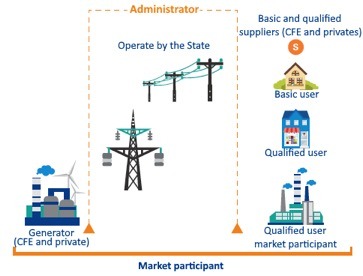
To gather all new participants, the government created a new wholesale electricity market. The Mercado Eléctrico Mayorista (MEM), which started operating in January 2016. So, participants of this market are the generators and the suppliers mentioned in the previous figure. They bargain their electricity at long-term (15-20 years), mid-term (3 months to 3 years) and short-term (real time to one day). Thus under the supervision of the CENACE (Centro Nacional de Control de Energía).
Because the price of the electricity is now changing every day, and each company has an interest to invest in new projects. And to diversify its strategies to Selling Energy in Mexico at the lowest price. [4]
Impact of the new selling model on the photovoltaic market
Mexico is one of the five countries with the greatest solar potential in the world. With an average of 5kWh/m² of solar energy receive each day. Nearly the double than the product average of Germany, the biggest European producer.
Studies showed that the potential sun energy received in Mexico could provide 50 times the total energy needed in the country. [5] The government is well aware of this fact. And with the constitutional reform in 2013, it attempts to take full advantage of this huge potential. This by encouraging the solar production at most, with tools as fiscal laws or new contractual schemes.
Under the constitutional reform, the government of Mexico established two fiscal laws to favour the investment in renewable energy.
In one hand, in the Law of General Taxes of Importation and Exportation (Ley de los Impuestos Generales de Importación y Exportación). It says that the anti-pollution devices are exempted of taxes. This, if the company fulfill the guidelines established by the secretary of Environment and Natural Resources (Medio Ambiante y Recursos Naturales), and by the secretary of Economy (Economia). It means that the solar panels are exempted of any importation and exportation taxes.
In the other hand, in the Law of the Rental Taxes (Ley del Impuesto sobre la Renta). It says that all investment made in renewable energy will be 100% tax deductible. It means that you can deduct taxes when you acquire solar panels from the first year of your annual declaration. [5]
Types of contracts available
With this new selling model come new models of design and new contracts of interconnection. This will simplify the access to the electricity market. The three types of contracts proposed for a photovoltaic system connected to the grid are the Net Metering, the Net Billing and the Total Selling:
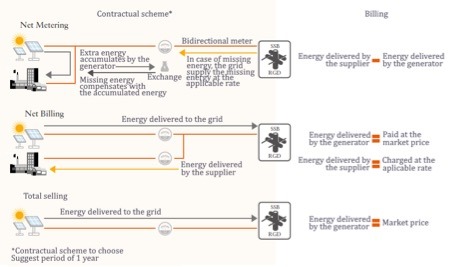
Net metering
The Net Metering is a method which combines the own consumption and the dispatch of electricity on the grid. The system works as follow: All the produced energy that can be directly consumed is used. If the customer needs more energy than he produces, the grid will supply the missing energy. Otherwise, if the customer produces more energy than he needs, he will send it to the grid. At the end of the month, three situations are possible:
- The customer produced more energy than he consumed: He/She will bank this excess of energy. This means that he will not be Selling Energy in Mexico. But will have the possibility to «pay» his futures excess of consumption with this banked energy.
- The customer produced less energy than he consumed. But possess energy in his bank: As said before, the customer will not pay for his net usage. He will use the energy he has banked the year before, when he has produced more energy than he has consumed.
- The customer produced less energy than he consumed and do not possess energy in his bank: The customer will then pay the energy supply by the grid at the applicable rate.
Let’s take an example to understand better the Net Metering method:
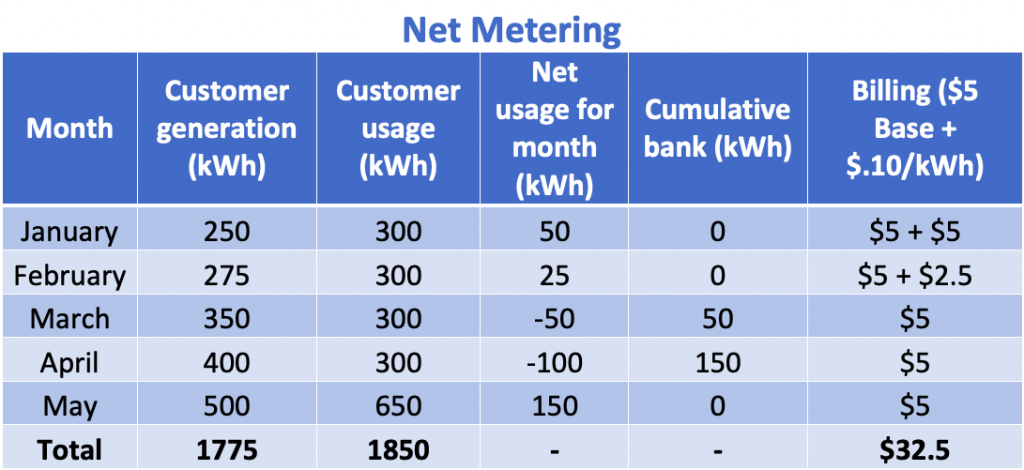
With the Net Metering method, when the customer used more power than he produced (January and February), he paid the difference. When he produced more than he consumed, he did not get any money for his extra energy, but he banked it. In May, as he consumed more energy than he produced, he used the energy he had banked and did not pay extra money for what he consumed. His total billing costs is $32.5.
Net billing
The Net Billing contract is based on the same principle that the Net Metering contract. The customer consumes directly his own production, sends the excess to the grid and receives energy from the grid when he needs. So the difference with the Net Metering method is that the customer can not bank energy. At the end of the month, only two situations are possible:
- The customer produced more energy than he consumed. He will be Selling Energy in Mexico to the CFE. They will pay for his excess of production to the grid at the market price.
- The customer produced less energy than he consumed. The grid will supply his energy at the applicable rate
Let’s take the precedent example, this time apply to the Net Billing contract:
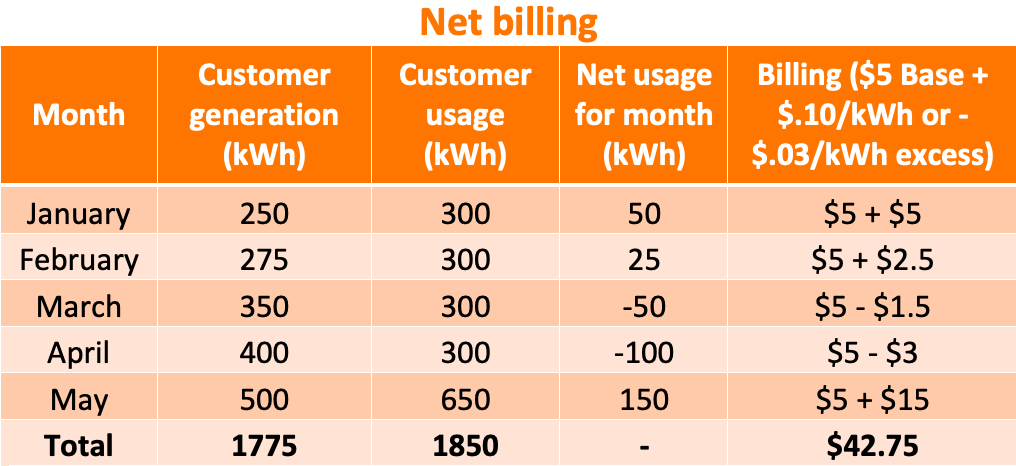
Under the Net billing principles, the customer has to pay the retail rate of $.10/kWh when he pulls energy from the grid. But is paid $.03/kWh for the excess of energy he produces. With this method, with the same data of consumption and production each month, the customer will have a bill of $42.75.
Total Selling
The Total Selling contract, contrary to the two precedents contracts, does not include the own consumption. All the production is sold to the grid, and all the consumption is bought at the applicable rate.
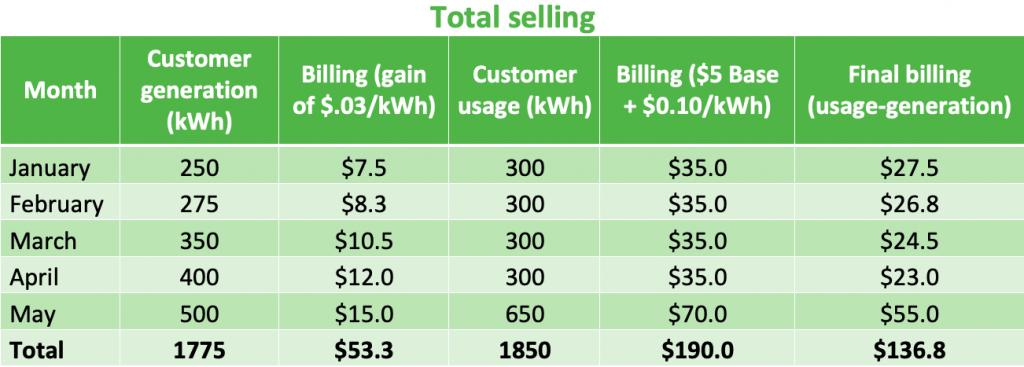
This time, the customer will have two separates bills. One where he gains money for the sale of his production to the CFE ($53.3$). And one of what he has to pay for his consumption ($190). If we deduce the gain of the customer to what he paid, the final billing of the customer will be $136.8.
Watch out, in this example we took the same data to stay consistent, but in reality CFE does not buy the energy at the same price on a Total Selling contract than on a Net Billing contract.
Actually, CFE may buy the energy at a higher price in the case of a Total Selling contract. In the previous example, the customer has a better interest in the Net Metering method.
Over one year and with different data, this difference between each method could be higher. But this does not mean the Net Metering method is always the most profitable. Depending on the customer’s way to consume, his production and the price of the energy on the market, the Net Billing or the Total Selling contract may be more profitable for the user.
This is why it is important to choose a solar installer who understand well the energy market. And who can help you all along your project to take the right choices.
Conclusion
The solar power currently represents less than 1 percent of Mexico’s total installed capacity. Although, Mexico is considered having one of the world’s best potential solar resources.
The government is aware of this fact and set up a full range of tools to develop the production of clean energy. Such as the opening of the energy market to the competition by the creation of the MEM.
The State hopes to reduce at most the price of the electricity. And, in order to do this, placed a huge bet on the development of new and renewable energies.
Therefore, to encourage the residents and the industries to invest in the solar energy, the constitutional reform introduced fiscal laws as a 100% tax deduction on the renewable energy materiel.
Also, with the collaboration of the CRE, proposed a variety of contractual scheme. Those, to allow every customer to make the most of this new energy.
The photovoltaic technology has a huge growth potential in Mexico. And its development only begin.
That is why now is the best time to invest in solar panels. Either to save money while protecting the environment, and/or to selling energy in Mexico!
¡You can also sell energy!
Fuentes
- KPMG, «Oportunidades en el sector eléctrico en México,» [Online]. Available: https://home.kpmg/content/dam/kpmg/mx/pdf/2016/10/DEmx-oportunidades-sector-electrico.pdf. [Last accessed: 11 February 2019].L.
- VIscidi,VIscidi, «Mexico’s Renewable Energy Future,» [Online]. Available: https://www.wilsoncenter.org/sites/default/files/mexico_renewable_energy_future_0.pdf. [Last accessed: 11 February 2019].
- K.L.E. Institute, «The current electricity marker design in Europe,» [Online]. Available: https://set.kuleuven.be/ei/images/EI_factsheet8_eng.pdf/at_download/file. [Last accessed: 11 February 2019].
- A.E. Energiepartnerschaft, «Nueva Era de la Energía en México,» [Online]. Available: https://www.energypartnership.mx/fileadmin/user_upload/mexico/media_elements/reports/NuevaEraEnergiaMexico_ESP.pdf. [Last accessed: 11 February 2019].
- Promexico, «La industria solar fotovoltaica y fototérmica en México,» [Online]. Available: http://www.promexico.mx/documentos/biblioteca/industria-solar.pdf. [Last accessed: 11 February 2019].
- O. E. Solar, «Guide to net metering and net billing,» [Online]. Available: https://osceolaenergy.com/guide-net-metering-net-billing/. [Last accessed: 11 February 2019].
- Desarrollo Sustentable, CFE
- CRE

